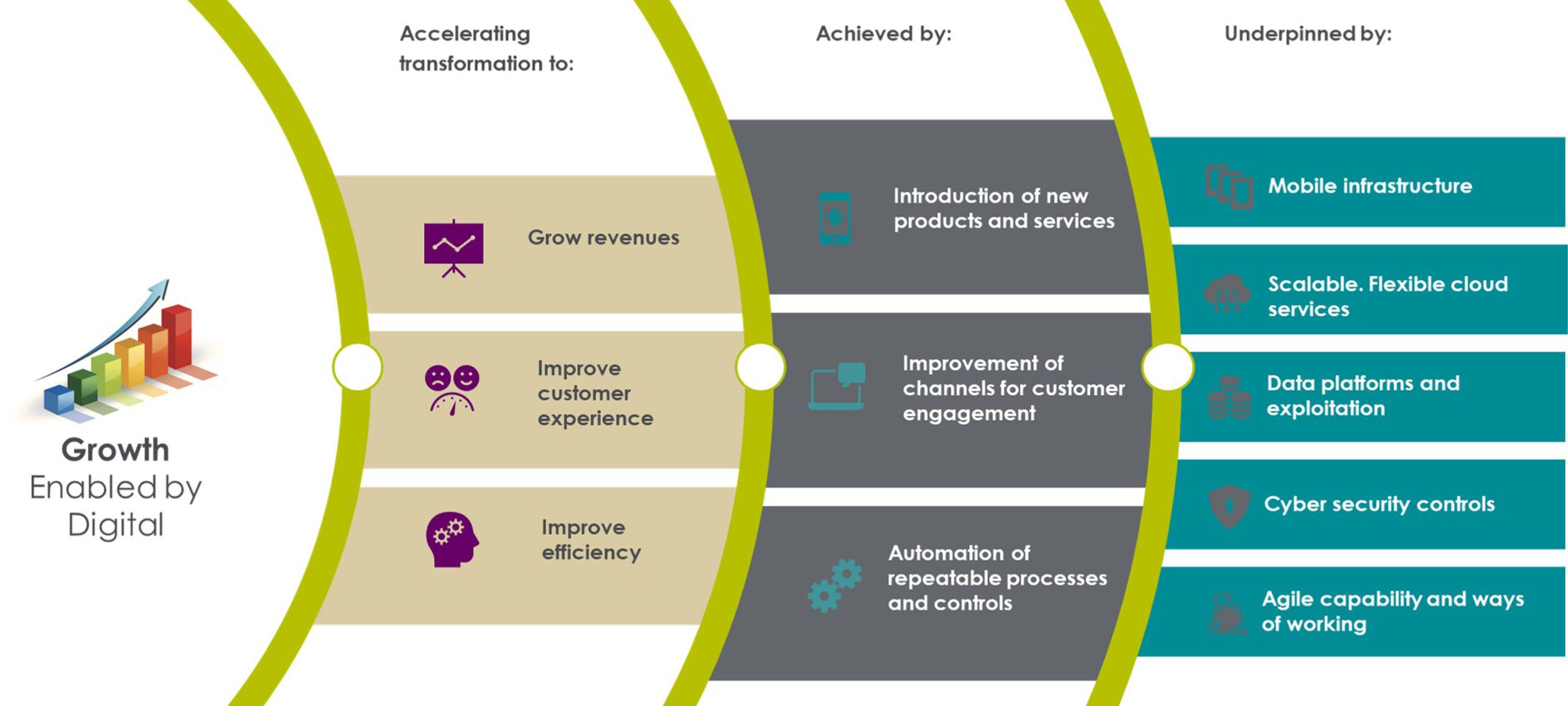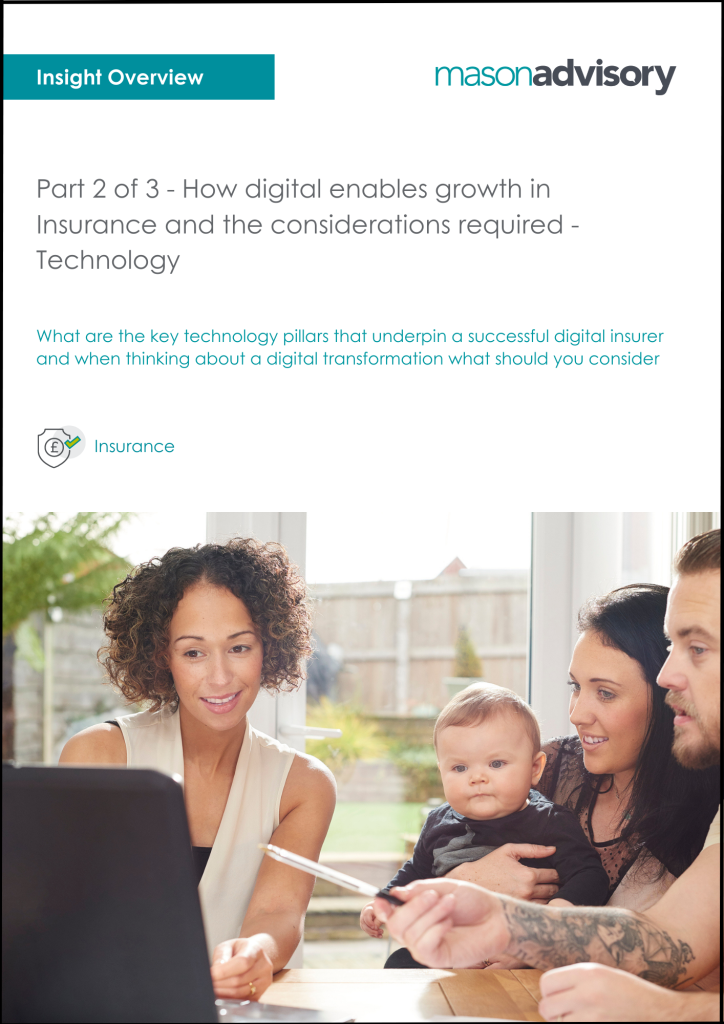Part 2 of 3 - How digital enables growth in Insurance and the considerations required – Technology
Share:
Date:
May 2023

key fact
Digital capability remains a key investment area for Insurers seeking to achieve their strategic goals
What are the key technology pillars that underpin a successful digital insurer and when thinking about a digital transformation what should you consider
As a reminder, in the first article we set out that ‘digital’ is in essence, a modernised business strategy and operating model that harnesses modern technology to underpin its aims:
Figure 1 – how digital underpins growth
While it is imperative that insurance companies build their digital thinking through the customer experience lens, if the appropriate foundations are not in place internally, this will impact their effectiveness and efficiency.
The exact scope of a digital transformation is unique to each organisation, but from a technology perspective can be developed around six key areas; each being considered from both a customer and internal lens. For an organisation at the start of its digital maturity all six will require development, while organisations that have already achieved a level of maturity might just need to focus on a couple of key areas. However, it is important to retain a level of curiosity and control across all areas regardless of maturity level. In a digital business world, maturity is a point in time rather than enduring.
The six areas of technology focus are:
1. Keeping you safe online
To keep customers safe organisations need to protect their assets, and in a digital world the majority of assets are online. Information protection and security has become even more critical. Staying abreast of newer methods of information protection and resilience can be difficult for organisations, but the following aspects need to be established as a minimum:
- an agreed and appropriate cyber strategy and associated roadmap
- regular health checks of your cyber defences
- security by design – build it into your capability at the beginning
- development of your security operations and response capability
- mature and up-to-date business continuity management plans which are regularly tested.
2. Maximising modern technology
While long standing insurers have legacy IT estates to deal with, new players in the market can move and adapt quickly utilising modern architectures and technologies. Organisations need to move away from the traditional full stack model and towards a composable/plug and play type model, alongside automating integrations and standard tasks, thereby freeing people to focus on driving value. Embracing new configurable applications to reduce cost of change, and working in partnership with InsurTech will realise the capabilities of new technologies. Consideration should be given to:
- Modern architectures – how to move towards a capability-based, composable and potentially subscription-based technology estate.
- Application estate – for those with legacy estates, how to advance to a simplified, configurable set of applications. And for the younger entrants, how to truly scale matching desired capabilities to the appropriate application functionality.
- Automation – driving automation within the appropriate areas and doing it right first time, rather than as an additional layer.
- Adapting to interact with connected devices, e.g., cars, sensors in property (residential and commercial), and wearables for health.
- Innovating with new disruptive technologies to enhance the customer and employee experience driving additional value.
3. Intelligent data insights and moving to data-led
Using data to provide the right solutions based on customer needs, make it a hugely important asset to any insurance organisation. Data exploitation is nothing new, however the opportunities available are expanding and it continues to revolutionise how insurance is built and sold, and data sharing is a hot topic. Again, an organisation’s maturity will dictate where to focus, but all organisations should be thinking about:
- what their data strategy is and how their data can generate value
- how they use data to improve customer experience, personalisation, accuracy
- how best to efficiently exploit the volume of data available across multiple platforms / partners, to drive top-line growth
- what challenges need addressing to realise the full value e.g., additional risk, additional governance effectiveness.
4. Flexible infrastructure
Attitude to infrastructure has changed. It has become more of a commodity purchase based on consumption rather than a large, costly capital outlay. Being able to respond to customers’ expectations in an ‘on demand’ world, requires organisations to be ready to scale or reduce consumption in line with demand. Hence the need for cloud-based solutions, faster, secure networks and flexible workplace solutions. We would suggest that organisations:
- exploit cloud by fully understanding the operating model required and the TCO impacts. Cloud is not usually an operational cost play, but more about enabling agility.
- modernise the network, e.g., moving to software-defined networking and considering a zero-trust network for increased cyber protection take advantage of cloud-based contact centre technologies, driving additional customer and employee experience, plus opportunity for additional efficiencies support their employees through modern workplace solutions.
5. Modern ways of working
In realising the benefits of a digital transformation, insurers need to review their ways of working and where necessary, change and adapt. Organisations should understand whether their operating model is fit for a digital business, and both the IT department and wider business should assess:
- what is their digital operating model? What needs to be different to operate effectively in a digital world?
- how to drive agility at scale
- embedding lean principles across the organisation
- right sourcing – what are the core skillsets to be retained versus the skillsets to be bought in?
- exploiting partnerships – recognising internal and external partnerships and the value they enable to drive the appropriate blend of capability.
6. Efficient and effective basics
Getting the basics right is core to any business in its daily operations. Transformation and digital are no exception. Unless the fundamentals are in place and working to the organisation’s advantage, the ability to realise wider benefits can be adversely impacted. There are three areas that we believe are critical:
- ensuring an organisation knows their technology cost profile – what the levers are that can be pulled to make efficiencies; and understanding how that profile may change in a digital world
- ensuring the IT and application estate performs to the service levels necessary to support the organisation’s goals; are the service management capabilities appropriate for a digital business model?
- ensuring the right technology controls are in place to meet the regulatory standards e.g., vulnerability management, GDPR.
Most organisations will have solutions in place to deal with the challenges and opportunities discussed above, but the questions really need to be:
- Are your solutions still fit for purpose in the digital world?
- Do you have the right foundations and enablers in place to help your business provide the experience and products that customers desire, alongside driving profitable growth?
- how regularly do you review the foundations and enablers to ensure they still support your digital goals?
To read Part 1 and 3 of this three part series, click on the links below:
- Part 1 of 3 – How Digital enables growth in Insurance and the considerations required
- Part 3 of 3 – How digital enables growth in Insurance and the considerations required – Customer experience & digital
If you would like to speak to Mike Kingston regarding the article, email our Financial Services & Insurance team to discuss further.
To download the insight click here
If you would like to find out more about the services we provide click here.

